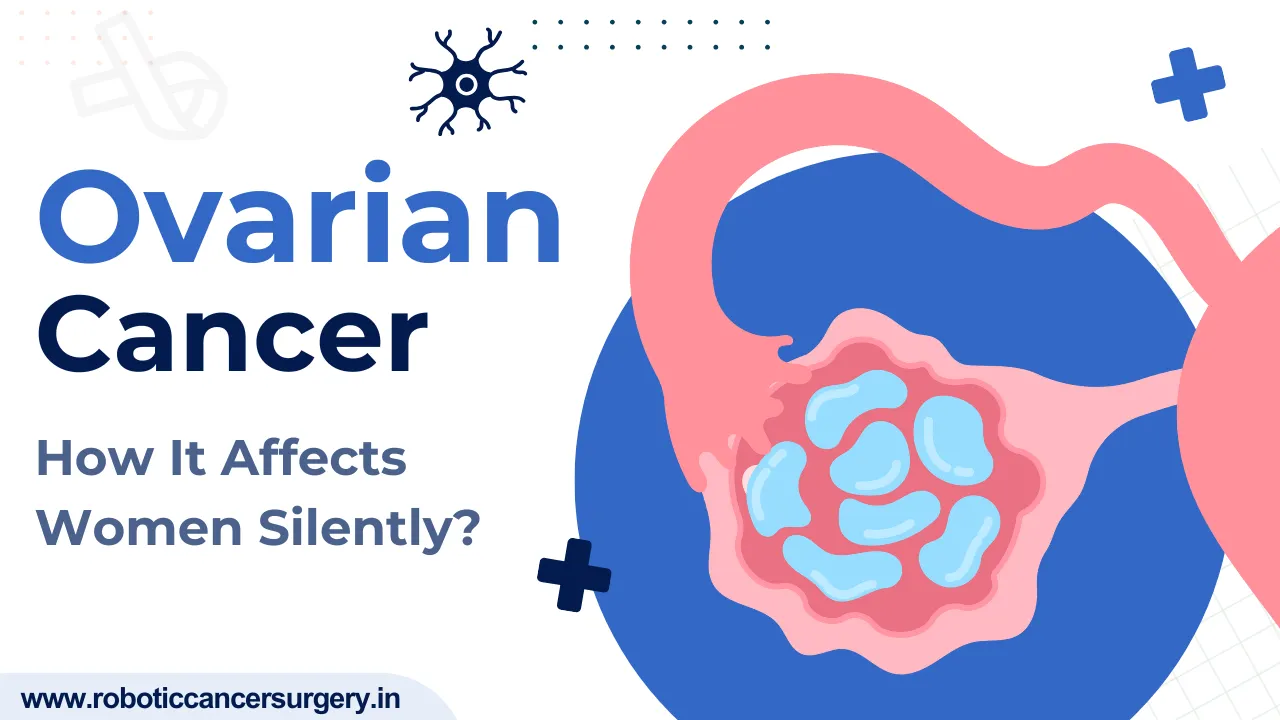Ovarian Cancer
How It Quietly Impacts Women's Lives?
Summary
- Causes
- Symptoms
- Diagnosis

Facts
- Ovarian cancer is a common type of cancer that affects women.
- It often develops slowly and doesn't show many symptoms at first.
- Although any woman can get ovarian cancer, it is more common in older women.
- Tests like pelvic exams and imaging scans help detect ovarian cancer early.
- Some women may have a higher risk if they have certain genes, like BRCA mutations.
Know More
- Ovarian cancer can grow slowly and might not show signs until it has spread.
- It usually starts with abnormal growths in the ovaries.
- Catching ovarian cancer early is important for successful treatment.
- Regular check-ups and knowing your family health history can help find it early.
- If treated early, ovarian cancer can be controlled with surgery and chemotherapy.
Symptoms
- Abdominal bloating or swelling
- Pelvic or abdominal pain
- Difficulty eating or feeling full quickly
- Urinary urgency or frequency
- Fatigue or feeling tired all the time
- Unexplained weight loss or gain
- Changes in bowel habits, such as constipation
- Back pain
- Menstrual irregularities or abnormal bleeding
- Pain during intercourse
⦿ Abdominal bloating or swelling: Bloating in the stomach that doesn’t go away after eating.
⦿ Pelvic or abdominal pain: A dull, persistent pain or discomfort in the pelvic or lower abdomen.
⦿ Difficulty eating or feeling full quickly: Feeling full after eating only a small amount of food.
⦿ Urinary urgency or frequency: A constant need to urinate or frequent trips to the bathroom.
⦿ Fatigue or feeling tired all the time: Unexplained exhaustion or lack of energy, even with rest.
⦿ Unexplained weight loss or gain: Sudden weight changes without changes in diet or activity levels.
⦿ Changes in bowel habits, such as constipation: Difficulty with bowel movements, often due to bloating or pressure.
⦿ Back pain: Persistent lower back pain not related to physical activity.
⦿ Menstrual irregularities or abnormal bleeding: Unusual or heavy menstrual bleeding, or changes in menstrual cycles.
⦿ Pain during intercourse: Pain or discomfort during sexual activity due to pelvic issues.
Causes
- Family history of ovarian or breast cancer
- Inherited gene mutations (e.g., BRCA1, BRCA2)
- Age (risk increases after menopause)
- Hormone replacement therapy (HRT) use
- History of endometriosis
- Personal history of breast or colorectal cancer
- Obesity
- Smoking and heavy alcohol consumption
- Never being pregnant or having difficulty conceiving
⦿ Family history of ovarian or breast cancer: If close relatives have had ovarian or breast cancer, it increases the risk.
⦿ Inherited gene mutations (e.g., BRCA1, BRCA2): Changes in genes can make it more likely to get ovarian cancer.
⦿ Age (risk increases after menopause): Women over 50 have a higher risk, especially after menopause.
⦿ Hormone replacement therapy (HRT) use: Long-term use of hormone therapy after menopause can increase the risk.
⦿ History of endometriosis: A condition where tissue similar to the uterine lining grows outside the uterus, raising the risk of ovarian cancer.
⦿ Personal history of breast or colorectal cancer: Having had other cancers can increase the risk of ovarian cancer.
⦿ Obesity: Being overweight or obese raises the risk of ovarian cancer due to hormonal changes.
⦿ Smoking and excessive alcohol consumption: Lifestyle choices like smoking and drinking can increase the risk of ovarian cancer.
⦿ Never being pregnant or having difficulty conceiving: Not being able to have children or not having children can slightly increase the risk.
Diagnosis
- Pelvic examination to feel for abnormal masses
- Transvaginal ultrasound to check for tumors or abnormalities
- CA-125 blood test to detect elevated tumor marker levels
- CT scan or MRI to evaluate the size and spread of tumors
- Biopsy to confirm cancerous cells
- Laparoscopy to examine the pelvic area and take tissue samples
⦿ Pelvic examination to feel for abnormal masses: A physical check for any unusual lumps or swelling in the pelvic area.
⦿ Transvaginal ultrasound to check for tumors or abnormalities: An ultrasound used to get a clearer view of the ovaries and detect any abnormalities.
⦿ CA-125 blood test to detect elevated tumor marker levels: A blood test to measure the CA-125 protein, which is often high in ovarian cancer.
⦿ CT scan or MRI to evaluate the size and spread of tumors: Imaging techniques to determine how far cancer has spread and its size.
⦿ Biopsy to confirm cancerous cells: A tissue sample is taken to confirm the presence of cancer cells in the ovary.
⦿ Laparoscopy to examine the pelvic area and take tissue samples: A minimally invasive procedure to look at the abdominal organs and collect tissue for testing.
Treatments
- Surgery to remove the ovaries, fallopian tubes, and other affected tissues
- Chemotherapy to destroy cancer cells or shrink tumors
- Targeted therapy to block cancer cell growth
- Hormone therapy to block hormone-related tumor growth
- Immunotherapy to boost the body’s immune system against cancer
- Radiation therapy, though less commonly used, may be considered
- Clinical trials to explore new treatment options
⦿ Surgery to remove the ovaries, fallopian tubes, and other affected tissues: Surgical removal of the ovaries and other affected organs to control the spread of cancer.
⦿ Chemotherapy to destroy cancer cells or shrink tumors: The use of drugs to kill cancer cells or shrink tumors, often after surgery.
⦿ Targeted therapy to block cancer cell growth: Drugs that target specific molecules to stop cancer cells from growing or spreading.
⦿ Hormone therapy to block hormone-related tumor growth: Medications to block or reduce hormones that promote the growth of certain ovarian cancers.
⦿ Immunotherapy to boost the body’s immune system against cancer: Treatment that helps the immune system identify and attack cancer cells.
⦿ Radiation therapy, though less commonly used, may be considered: High-energy rays are used to target and shrink tumors, usually in more advanced cases.
⦿ Clinical trials to explore new treatment options: Participation in studies to test the effectiveness of new treatments and medications.
Treatment Options and Outcomes
| Treatment Option | Description | Purpose | Outcome/Effectiveness | Side Effects |
|---|---|---|---|---|
| Surgery (Oophorectomy) | Removal of ovaries, fallopian tubes, and surrounding tissues to eliminate cancer. | To remove cancerous tissue and reduce the spread of the disease. | Effective for localized cancer; improves survival if the cancer is contained. | Pain, infection, bleeding, hormonal changes. |
| Chemotherapy | Use of drugs to kill cancer cells or shrink tumors. | To destroy remaining cancer cells after surgery or reduce tumor size. | Can significantly shrink tumors, often used as adjuvant therapy. | Nausea, fatigue, hair loss, immune suppression. |
| Targeted Therapy | Drugs that target specific cancer cells without harming normal cells. | To inhibit cancer cell growth by targeting molecular abnormalities. | Effective in some cases, particularly for cancers with specific mutations. | Diarrhea, fatigue, skin problems. |
| Hormone Therapy | Treatment to block hormones that fuel tumor growth. | To slow or stop the growth of hormone-sensitive cancers. | Used when cancer is hormone-receptor positive; can manage recurrence. | Hot flashes, mood swings, fatigue. |
| Immunotherapy | Treatment that boosts the body’s immune system to fight cancer. | To enhance immune response against cancer cells. | Still experimental for ovarian cancer, but promising in some cases. | Fatigue, immune-related side effects, rashes. |
| Radiation Therapy | High-energy radiation used to target cancer cells. | To shrink or eliminate residual cancer cells. | Less commonly used; may be effective for localized spread. | Skin irritation, fatigue, nausea. |
| Clinical Trials | Participation in studies for new treatment options. | To test new therapies and treatments for effectiveness. | Can offer access to innovative treatments and better outcomes. | Side effects vary depending on the trial treatment. |
Questions to Ask Your Doctor
- What stage is my ovarian cancer, and how does this affect my treatment options?
- What are the potential side effects of the treatment options you recommend?
- Are there any clinical trials available for my condition that I could consider?
- What are the chances of recurrence, and how can I monitor my health after treatment?
Frequently Asked Questions
What are the main symptoms of ovarian cancer?
Common signs include bloating in the stomach, pelvic pain, trouble eating, and changes in urination, but these can also be caused by other conditions.
How is ovarian cancer diagnosed?
Ovarian cancer is diagnosed through pelvic exams, blood tests (like CA-125), ultrasounds, and sometimes a biopsy or CT scan for confirmation.
What are the treatment options for ovarian cancer?
Can ovarian cancer be prevented?
What is the survival rate for ovarian cancer?
What are the risk factors for ovarian cancer?
Can ovarian cancer return after treatment?
How does ovarian cancer affect fertility?
Are there any alternative treatments for ovarian cancer?
What is the role of genetic testing in ovarian cancer?

Written by
Dr. Swati Shah
MS, DrNB (Surgical Oncology)
Dr. Swati Shah is a Robotic Uro and Gynecological Cancer Surgeon in Ahmedabad.

Reviewed by
Dr. Harsh Shah
MS, MCh (G I cancer Surgeon)
Dr. Harsh Shah is a renowned GI and HPB Robotic Cancer Surgeon in Ahmedabad.
